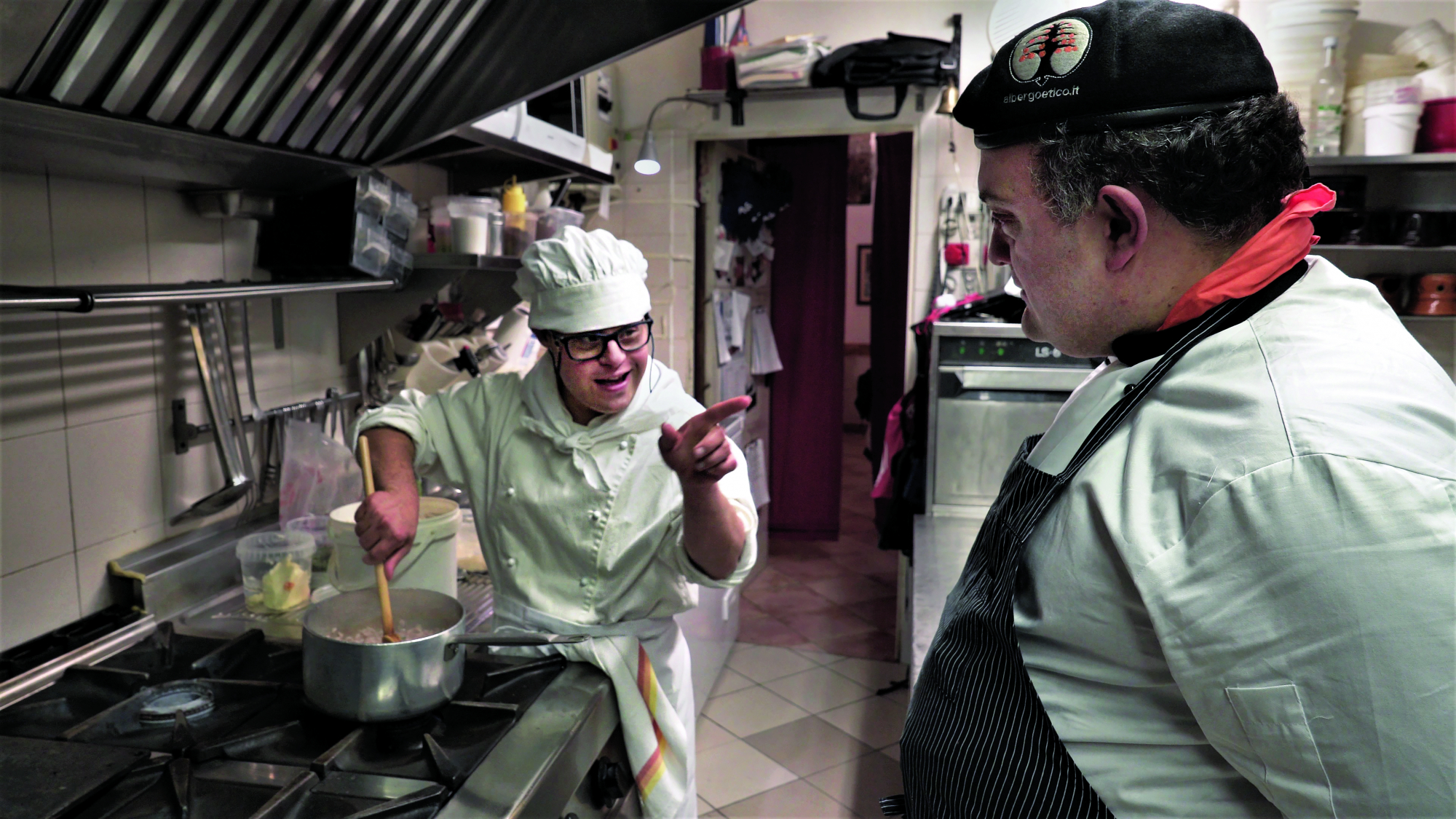In pondering the evolution of the modern documentary feature, influential film scholar Bill Nichols invites us to consider whether filmmakers have ‘broadened the appeal of documentary by [making it] more like feature fiction films’ in its use of elements such as characterisation, music, animation, re-enactments and so on.[1]Bill Nichols, Introduction to Documentary, 3rd edn, Indiana University Press, Bloomington, IN, 2017, p. 4. Because feature documentaries very much compete alongside fictional film narratives for audience attention – especially on the film festival circuit – elements of style are important to engage audiences, illuminate the subject and connect them with the social issues presented.
Nichols’ seven modes of documentary style remain a useful tool in examining the interplay of artistic choices in a film. One of these is likely to be very familiar to audiences: ‘observational mode’, which, Nichols states, ‘emphasizes a direct engagement with the everyday life of the subjects as observed by an unobtrusive camera’.[2]ibid., p. 22. This style is employed in Chef Antonio’s Recipes for Revolution (Trevor Graham, 2021), a documentary that tells the story of the titular Italian chef’s desire to marry his loves of food and family by changing the lives of young people with Down syndrome. Antonio de Benedetto’s restaurant and hotel in the northern Italian city of Asti each bring young men and women from around the country to live and work together; for many of them, this is the first opportunity they have been given to develop real-world skills and independence while being nurtured in a family environment. For a large proportion of the film, the camera follows de Benedetto and his employees in the two establishments, and occasionally to their homes. Graham identifies the film’s style as observational, describing it as a ‘slow boil [… in which] the story evolves over time’ – in this case, through seven shoots over three years.[3]Trevor Graham, ‘Trevor Graham on the Winding Journey to Official Co-production Status’, IF.com.au, 28 August 2020, <https://www.if.com.au/trevor-graham-on-the-winding-journey-to-official-co-production-status/>, accessed 25 February 2022. However, this style is combined with what Nichols refers to as the ‘participatory mode’, which involves interaction between filmmaker and subject (for instance, via interviews or use of historical or archival materials).[4]Nichols, op. cit., p. 22.
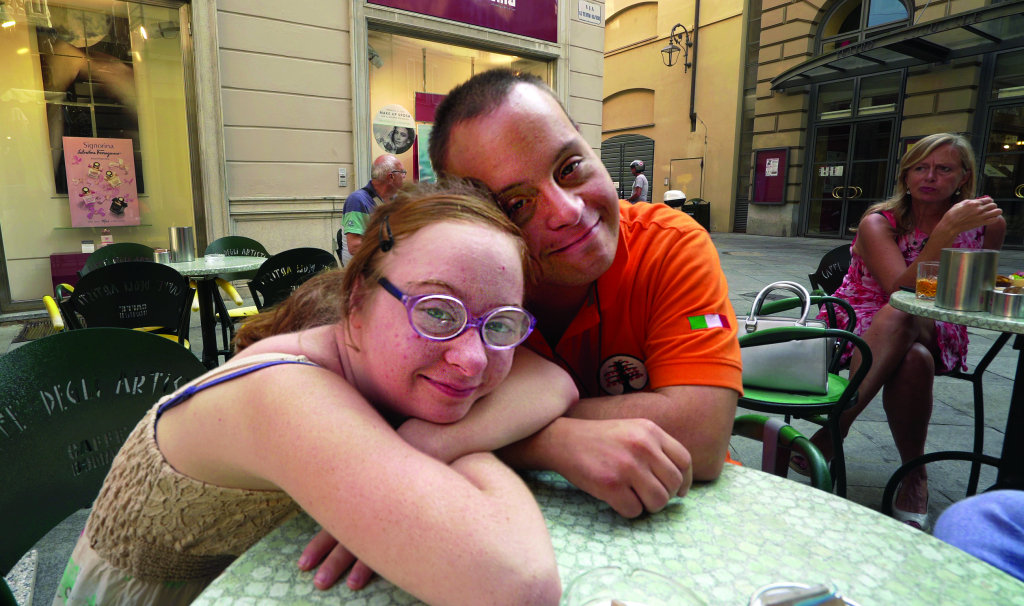
In this film, interaction with the camera emerges naturally during the observational sequences: de Benedetto often speaks to the camera while in the kitchen, making asides about what he is teaching the staff or commenting on their wellbeing. Likewise, as the camera follows maître d’ Niccolò Vallese up and down the restaurant stairs, he often comments on what he is doing or the work of other staff in the dining room. Archival material is present, too: childhood photos of the subjects are incorporated as aspects of their personal stories, recounting how they came to be part of de Benedetto’s family. The film also tweaks the traditional ‘expository mode’ defined by Nichols, which involves voiceover narration,[5]ibid. by using the voices of three of the key participants – de Benedetto, waitress and aspiring pâtissière Jessica Berta, and trainee chef Mirko Piras – as opposed to a narrator who is external to the action. While talking-head interview sequences are largely absent from the film, it’s clear from the extent of the voiceover material that such recordings must have been conducted off screen. As such, the subjects’ story is, as the film’s publicity material puts it, essentially ‘told in first person’.[6]Yarra Bank Films, Black Sheep Films & La Sarraz Pictures, Chef Antonio’s Recipes for Revolution press kit, 2020, p. 2.
The portrayal of a documentary subject or ‘character’ on screen can be just as important to engaging the audience as it is in a scripted work.
The portrayal of a documentary subject or ‘character’ on screen can be just as important to engaging the audience as it is in a scripted work; viewers can become as invested in finding out how the narratives presented in a documentary will resolve as they may be when viewing a binge-worthy drama. Nichols refers to the subjects depicted in documentaries as ‘social actors’ who are ‘not performing for the camera’[7]Nichols, op. cit., p. xii. but merely ‘play’ themselves.[8]ibid., p. 6. One could argue, however, that there is always some aspect of performance in documentaries, whether in observational or participatory[9]Nichols describes this mode as involving ‘interaction between filmmaker and subject’, which may include interviews, conversations and archival material; see ibid., p. 22–3. mode. As Nichols puts it, the subjects may often be ‘acutely aware of the camera’s presence’, but he argues that this is not so different from the way we present ourselves in various situations in everyday life, such as when meeting a new person or interacting with those familiar to us; we naturally learn to play the roles of various versions of ourselves.[10]ibid., p. 6. Therefore, subjects’ awareness of the camera should not necessarily indicate a lack of authenticity in their depiction.
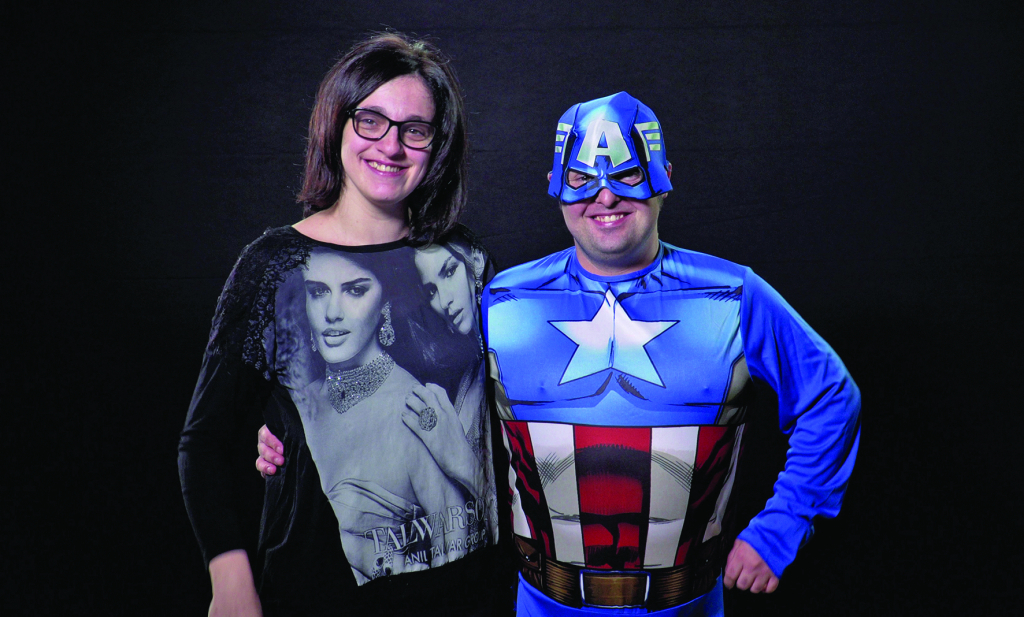
In an analysis of the classic US documentary The Life and Times of Rosie the Riveter (Connie Field, 1980), media scholar John Corner explores the notion of ‘interviewee as “character”’, observing that the film offered a break from conventional documentary style, in which interviewee dialogue had traditionally been seen as ‘necessarily subordinate to an expository discourse’. Instead, the subjects of the film – five female factory workers – are the narrative.[11]John Corner, The Art of Record: A Critical Introduction to Documentary, Manchester University Press, Manchester & New York, 1996, p. 128. While the interviews and observational footage of the participants of Chef Antonio’s Recipes for Revolution undoubtedly support the overall focus on de Benedetto’s project, their individual narratives are given time to develop as well. As Corner observed with regard to Rosie the Riveter’s participants, Graham’s subjects are also given ‘personal “space”’ to occupy in the film.[12]ibid, p. 130. This is exemplified by the film’s exploration of the lives of the characters beyond the restaurant and hotel. One of the key narrators, Piras, is given plenty of screen time outside the kitchen; in settings including a family dinner at his home, we explore his romance with Francesca Buzzi – a young woman from his home town who also has Down syndrome – and his relationship with his mother. Later in the film, Piras suffers a heart attack and is hospitalised (the incident itself is depicted in animation with voiceover), with subsequent visits to the hospital by friends and family and his recovery covered in observational style. Berta and Vallese’s ten-year romance, a more mature relationship than Piras and Buzzi’s, is also given some screen time outside of the restaurant setting: for Vallese, this shows us a softer side of his personality; while for Berta – whom, we discover, spent a large portion of her life in community care, estranged from her family, before coming to work for de Benedetto – the sequences illuminate the personal as well as professional freedom this job has given her.
Nichols’ definition of ‘performative mode’ in documentary incorporates ‘evocation and affect [… with] emphasis on what it feels like to inhabit the world in a specific way or as part of a specific subculture’.[13]Nichols, op. cit., p. 22. In the case of Chef Antonio’s Recipes for Revolution, the subculture being explored comprises those who work in hospitality. For anyone who has worked in this industry, there is an identifiable set of behaviours and quirks that arise from long, often late, hours spent together in kitchens and dining rooms. De Benedetto willingly invites us into this world with all its accompanying pressures, challenges that build closeness (and sometimes conflict) between co-workers. It is clear he intends his staff to have an authentic experience of this type of workplace; while de Benedetto may not typify the angry, sweary Gordon Ramsay–type chef, he does raise his voice when talking to the employees and apply pressure when needed. His lack of a potty mouth is made up for by Vallese, who curses to camera over a mistake he’s made – it’s a jarringly funny moment for the audience, but less shocking for those of us who have worked in restaurants. Piras admits to having been reduced to tears by de Benedetto, but sees the latter’s strictness as a necessary factor in his own growth as a chef.

Among these observational sequences, an interesting stylistic flourish recurs: a series of short black-and-white sequences peppered throughout the film in which subjects appear against a dark background. Showing a more playful side to the documentary participants – who are silent apart from music or voiceover, and often look directly at the camera – these vignettes highlight who they are as people and give them permission to play to the camera. For example, de Benedetto is seen sharpening his knives; Piras and Buzzi, dancing together; Piras, hugging his mother; Vallese, dressed as a superhero; and Berta, smiling shyly. These sequences could also be viewed as instances of Nichols’ ‘performative mode’, in that they are evocative cinematic portraits of the subjects, with the black-and-white cinematography elevating them to movie-star status; these are the heroes of de Benedetto’s ‘revolution’.
While observation is a key feature of the film, we are also reminded that there are different forms of looking. When travelling home alone by train, Piras confides that people often stare at him: ‘They don’t see me; they see Down syndrome.’ Advocacy organisation Down Syndrome Australia backs up this perception:
Despite much change, many people still don’t see the individual person. Instead they just see ‘Down syndrome’ and expect everyone with Down syndrome to be more or less the same […] People with Down syndrome experience all the same emotions as everyone else.[14]Down Syndrome Australia, About Down Syndrome: Fact Sheet, p. 2, <https://www.downsyndrome.org.au/wp-content/uploads/2021/02/About-Down-Syndrome_English_2021.pdf>, accessed 26 December 2021.
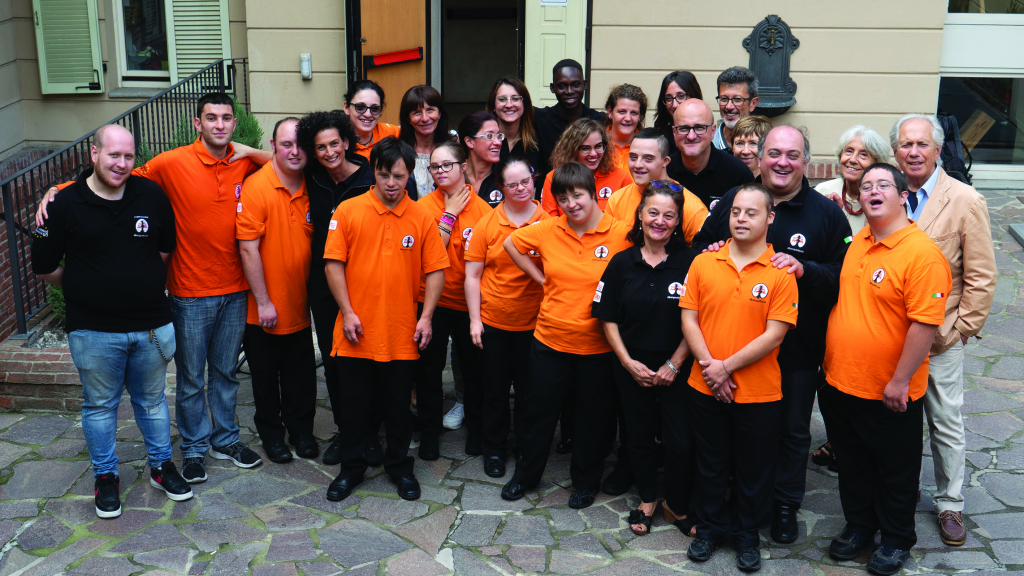
Many of us grew up in a culture of being told ‘not to stare’ at those with a disability. Campaigner Tanya Marlow observes that ‘polite adults are conditioned to look away from disabled people because they fear saying or doing the wrong thing’,[15]Tanya Marlow, ‘Don’t Tell Your Child Not to Stare at Disabled People – We Are Already Invisible Enough’, The Guardian, 11 October 2018, <https://www.theguardian.com/society/2018/oct/11/dont-tell-your-child-not-to-stare-at-disabled-people-we-are-already-invisible-enough>, accessed 26 December 2021. pointing out that she (as a wheelchair user) prefers direct eye contact. Marlow also references advice from author Alice Broadway – who has an autistic son with Down syndrome – that children should not be discouraged from staring, as this reaction ‘communicates shame’.[16]ibid. Chef Antonio’s Recipes for Revolution doesn’t just invite us to observe people with Down syndrome; it demands that we see them. Lingering camera shots of subjects’ faces invite us to stare at them and see the person beyond the syndrome, with beauty and flaws as diverse as those of anyone else. The documentary’s observational style likewise ensures that we see the participants as fully rounded individuals with their own (not necessarily always likeable) quirks and personality traits: for instance, Vallese is moody and bossy at times, while Piras antagonises and upsets shy dishwasher Nicky in one kitchen scene. The camera’s gaze never feels exploitative; much as de Benedetto sees his staff as they are, the film encourages viewers to approach them in the same way.
Lingering camera shots of subjects’ faces invite us to stare at them and see the person beyond the syndrome, with beauty and flaws as diverse as those of anyone else.
Chef Antonio’s Recipes for Revolution also reminds us that Down syndrome is a genetic condition that affects people differently. While everyone with the syndrome will have some level of intellectual disability, developmental delays and health risks, these can vary greatly among individuals.[17]See ‘What Is Down Syndrome?’, Down Syndrome Australia website, <https://www.downsyndrome.org.au/about-down-syndrome/what-is-down-syndrome/>, accessed 26 December 2021. What the film celebrates is that skills can be developed and nurtured on an individual basis. De Benedetto approaches each employee in terms of what they can do, rather than what they cannot. Their personalities as well as their abilities are taken into account, and each is a valued member of the team.
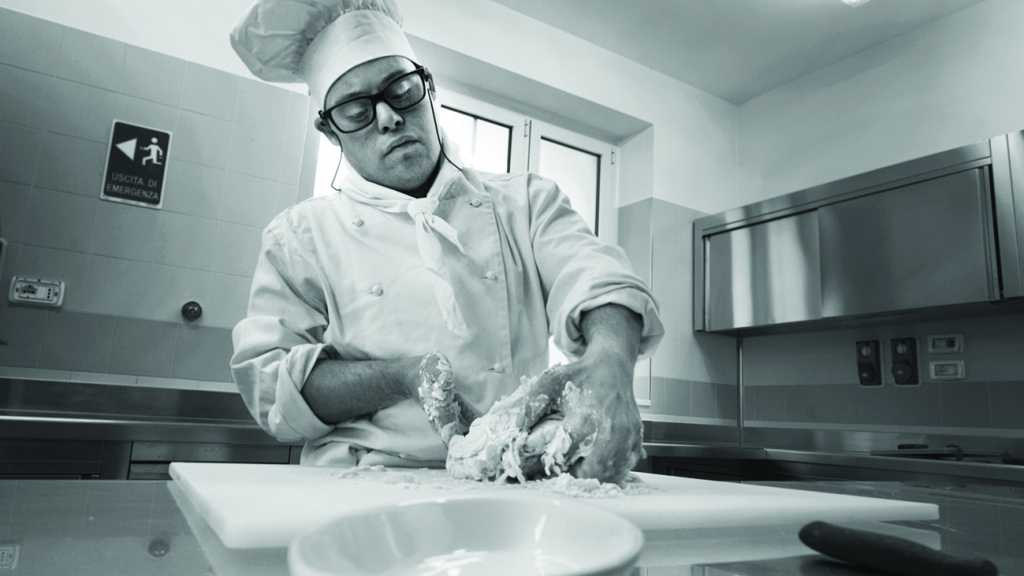
While acknowledging that their disability is what brought them to this story, the film does not specifically set out to educate its audience about Down syndrome; rather, through its representation of its subjects, it more subtly challenges and counters some common misconceptions. When Piras’ mother expresses concerns about her son and Buzzi’s plans to marry, any assumption that she feels this way due to their disability is quickly put to rest; she is more concerned about their bickering. Meanwhile, Nicky, who we discover has been largely non-vocal throughout his life, has begun to speak since working in the restaurant. When we observe de Benedetto teaching him to make pasta, he comments to camera that it’s a shame Nicky was not taught – as many other Italian youngsters are – to do this by his grandmother, speculating that there may have been an assumption that he was incapable of learning. As a teacher, de Benedetto is as strict with Nicky as he is with Berta and Piras; yet there is a tenderness to this interaction. Nicky’s physical tics – he often moves his hands in a flying bird- or butterfly-wing motion – are also captured on film with a subtle beauty.
The film’s funding page states that it is not intended as ‘“placard” filmmaking’, but is deliberately character- and story-led, offering a ‘social model for disability rights’.[18]‘Chef Antonio’s Recipes for Revolution’, Documentary Australia Foundation website, <https://documentaryaustralia.com.au/project/chef-antonios-recipes-for-revolution/>, accessed 25 February 2022. For Nichols’ part, he believes that we are currently experiencing a ‘golden age’ of documentary filmmaking, and that documentary form is the ‘flagship for a cinema of social engagement’.[19]Nichols, op. cit., p. 1. By combining a variety of documentary, narrative and cinematic elements to engage its audience, Chef Antonio’s Recipes for Revolution proves both statements true.
‘How do you see us?’ asks a title card at the end of the film. It is this concept that Graham’s documentary ultimately succeeds in conveying: that young people with disabilities deserve to be seen, and to be able to ‘take their place at the table of life’.[20]Yarra Bank Films, Black Sheep Films & La Sarraz Pictures, op. cit., p. 2.
Endnotes
| 1 | Bill Nichols, Introduction to Documentary, 3rd edn, Indiana University Press, Bloomington, IN, 2017, p. 4. |
|---|---|
| 2 | ibid., p. 22. |
| 3 | Trevor Graham, ‘Trevor Graham on the Winding Journey to Official Co-production Status’, IF.com.au, 28 August 2020, <https://www.if.com.au/trevor-graham-on-the-winding-journey-to-official-co-production-status/>, accessed 25 February 2022. |
| 4 | Nichols, op. cit., p. 22. |
| 5 | ibid. |
| 6 | Yarra Bank Films, Black Sheep Films & La Sarraz Pictures, Chef Antonio’s Recipes for Revolution press kit, 2020, p. 2. |
| 7 | Nichols, op. cit., p. xii. |
| 8 | ibid., p. 6. |
| 9 | Nichols describes this mode as involving ‘interaction between filmmaker and subject’, which may include interviews, conversations and archival material; see ibid., p. 22–3. |
| 10 | ibid., p. 6. |
| 11 | John Corner, The Art of Record: A Critical Introduction to Documentary, Manchester University Press, Manchester & New York, 1996, p. 128. |
| 12 | ibid, p. 130. |
| 13 | Nichols, op. cit., p. 22. |
| 14 | Down Syndrome Australia, About Down Syndrome: Fact Sheet, p. 2, <https://www.downsyndrome.org.au/wp-content/uploads/2021/02/About-Down-Syndrome_English_2021.pdf>, accessed 26 December 2021. |
| 15 | Tanya Marlow, ‘Don’t Tell Your Child Not to Stare at Disabled People – We Are Already Invisible Enough’, The Guardian, 11 October 2018, <https://www.theguardian.com/society/2018/oct/11/dont-tell-your-child-not-to-stare-at-disabled-people-we-are-already-invisible-enough>, accessed 26 December 2021. |
| 16 | ibid. |
| 17 | See ‘What Is Down Syndrome?’, Down Syndrome Australia website, <https://www.downsyndrome.org.au/about-down-syndrome/what-is-down-syndrome/>, accessed 26 December 2021. |
| 18 | ‘Chef Antonio’s Recipes for Revolution’, Documentary Australia Foundation website, <https://documentaryaustralia.com.au/project/chef-antonios-recipes-for-revolution/>, accessed 25 February 2022. |
| 19 | Nichols, op. cit., p. 1. |
| 20 | Yarra Bank Films, Black Sheep Films & La Sarraz Pictures, op. cit., p. 2. |
